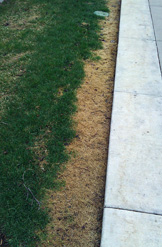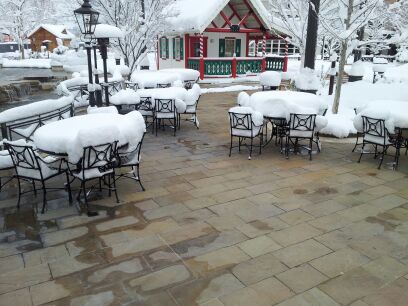Radiant heat is appealing to a growing number of home and business owners nowadays. In addition to its environmentally friendly features, radiant heat is also the most efficient heating technology today. The systems are used to heat homes as well as provide snow melting for driveways, sidewalks, steps, ramps, roofs, and more.
Fully automated snow melting systems not only eliminate the need to shovel and plow driveways, but also the need for salt and snow melting chemicals. Salt runoff from driveways and sidewalks can damage nearby plants and grass. When spring time rolls around, the damage can be apparent.
The common solution for homeowners is to shovel and then salt the driveway or walks to prevent ice from forming. This is the typical routine for most of us, but it can come at a cost to grass and other nearby plants. Salt runoff tends to seep into the nearby soil, causing long term damage to the lawn and surrounding landscape. When spring arrives, some lawns reveal the tell-tale signs of salt and snowmelt chemical use. Grass lining the edges of driveways and sidewalks looks brown and dead.

While the landscape can often bear the scars of winter, the cold, wet season can also take a toll on concrete driveways. “Spalling” is an unfortunate problem with some concrete driveways and sidewalks.
The term “spalling” refers to the crumbling, or disintegration, of the surface of a concrete slab. The damage is typically limited to less than a quarter of an inch deep. The smooth, finished surface breaks apart, and the rougher stone aggregate is revealed below. But why do some concrete surfaces crumble like this?
For the most part, concrete is very stable and permanent; however, it is also porous, so it will absorb water. During winter storms, small amounts of water can be trapped inside the concrete, where it freezes at night and pushes the cement binder apart. The expanding and contracting ice/water eventually breaks down the surface, causing the top layer to crumble. (Frozen water expands about 10%, which is enough to push areas of the top layer upwards, resulting in spalling.) So, in addition to helping to preserve the health of the adjacent lawn, radiant heat can also help to prolong the lifespan of concrete and paved driveways.
The obvious benefit of radiant heated driveways is the elimination of plowing or manual snow removal. The systems also greatly enhance safety. Automated snow melting systems have a built in “afterrun” function. This safety feature forces the driveway heating system to remain on for a short time after the snowstorm to dry the surface. This prevents slick ice from forming on the surface, while eliminating tiny pockets of water from freezing and damaging the concrete from within to dramatically reduce the chance of spalling.
In addition to the “convenience” features, radiant snow melting systems provide a host of other features and benefits. Some of these include:
Maintenance free: Once an electric snow melting system is installed, there’s no need for regular maintenance. Because these systems have no moving parts, they are virtually maintenance free.
Environmentally friendly: Clean operating snow melting systems help to preserve the health of nearby plants and grass by eliminating the need for harmful salt and harsh snow melting chemicals.
Fully automated: Radiant driveway heating systems are fully automated. The systems feature embedded heat cable, an advanced snow sensor (activation device), and a controller or contactor panel. The activation device is a compact, durable, high-tech snow sensor that detects temperature and precipitation. When precipitation is detected and the temperature is below the set point (typically set at 38°F), the sensor signals the controller, and then power is sent to the heating elements to warm the surface and prevent the accumulation of snow. (The systems also feature manual override capability so it can be manually triggered to deal with snowdrifts or other issues if needed.)

Safety: One of the most obvious benefits of automated snow melting systems is that of enhanced safety. The systems stand ready to activate when needed, assuring that sidewalks, steps, driveways, and other areas remain clear of snow and ice during the winter season.
Versatile, easy to customize: Automated driveway heating systems are easy to customize. The systems can be tailored to meet the homeowners’ precise layout, as well as their snow melting needs and budget. Small areas of a driveway can be heated, or heated tire tracks or any other configuration can be installed. ProLine professional system designers have provided layouts for commercial and residential customers throughout the country.
ProLine carries a wide range of industry-leading products. In addition to these proven products, ProLine also includes unmatched customer services, including free installation training, installation support, and professional system design and layout drawings. ProLine is the trusted wholesale provider of premier radiant heat solutions. For more details, call a friendly radiant heat expert today, at 866-676-9276.
